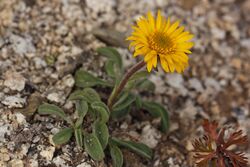Biology:Erigeron aureus
| Erigeron aureus | |
|---|---|

| |
| Scientific classification | |
| Kingdom: | Plantae |
| Clade: | Tracheophytes |
| Clade: | Angiosperms |
| Clade: | Eudicots |
| Clade: | Asterids |
| Order: | Asterales |
| Family: | Asteraceae |
| Genus: | Erigeron |
| Species: | E. aureus
|
| Binomial name | |
| Erigeron aureus Greene
| |
| Synonyms[1][2] | |
| |
Erigeron aureus, the Alpine yellow fleabane, is a species of flowering plant in the family Asteraceae, native to the Cascades and Rocky Mountains of northwestern North America (Alberta, British Columbia, Washington (state) ).[3][4] The specific epithet aureus means "golden yellow".[5]
Range and Habitat
Erigeron aureus is native to the Cascades and Rocky Mountains of northwestern North America (Alberta, British Columbia, Washington (state) ).[6] It grows in high mountains on exposed ridges and rocky slopes and in rock crevices.[3][7]
Description
Erigeron aureus is a very small, short-lived herbaceous perennial growing to 10 cm (4 in), rarely 20 cm (8 in) tall. It has tufts of hairy grey-green leaves with large solitary yellow daisy-like flower heads to 2.5 cm (0.98 in) wide, appearing in summer.[8][7][9][10]
Cultivation
Erigeron aureus is suitable for cultivation in a rockery, wall or similar sunny, well-drained site.
In the United Kingdom it thrives in the warmer western and southern coastal areas, though it is listed as hardy down to −10 °C (14 °F).[11] The cultivar 'Canary Bird', longer-lived than wild populations of the species, has gained the Royal Horticultural Society's Award of Garden Merit.[11][12]
References
- ↑ Tropicos, Erigeron aureus Greene
- ↑ The Plant List, Erigeron aureus Greene
- ↑ 3.0 3.1 Sullivan, Steven. K. (2015). "Erigeron aureus". http://www.wildflowersearch.com/search?&PlantName=Erigeron+aureus. Retrieved 2015-01-24.
- ↑ Biota of North America Program 2014 state-level distribution map
- ↑ Harrison, Lorraine (2012). RHS Latin for gardeners. United Kingdom: Mitchell Beazley. pp. 224. ISBN 9781845337315.
- ↑ Hitchcock, C.L. and Cronquist, A. 2018. Flora of the Pacific Northwest, 2nd Edition, p. 56. University of Washington Press, Seattle.
- ↑ 7.0 7.1 "Erigeron aureus". Flora of North America. eFloras.org. http://www.efloras.org/florataxon.aspx?flora_id=1&taxon_id=250066556.
- ↑ RHS A-Z encyclopedia of garden plants. United Kingdom: Dorling Kindersley. 2008. pp. 1136. ISBN 1405332964.
- ↑ Klinkenberg, Brian, ed (2014). "Erigeron aureus". Lab for Advanced Spatial Analysis, Department of Geography, University of British Columbia, Vancouver. http://linnet.geog.ubc.ca/Atlas/Atlas.aspx?sciname=Erigeron%20aureus. Retrieved 2015-01-24.
- ↑ Giblin, David, ed (2015). "Erigeron aureus". Burke Museum, University of Washington. http://biology.burke.washington.edu/herbarium/imagecollection.php?Genus=Erigeron&Species=aureus. Retrieved 2015-01-24.
- ↑ 11.0 11.1 "Erigeron aureus 'Canary Bird'". Royal Horticultural Society. https://www.rhs.org.uk/Plants/92566/Erigeron-aureus-Canary-Bird/Details. Retrieved 14 April 2020.
- ↑ "AGM Plants - Ornamental". Royal Horticultural Society. July 2017. p. 36. https://www.rhs.org.uk/plants/pdfs/agm-lists/agm-ornamentals.pdf. Retrieved 6 February 2018.
Wikidata ☰ Q1534536 entry
 |

